Relive the Biggest Takeaways from INBOUND Conference 2016 in Eight Minutes

Dave Schools, Former Digital Strategist
Article Category:
Posted on
The future of marketing, GrowthBot, the science of productivity, why Tesla doesn’t sell, and blog post virality
On the go? Tap here to listen to this blog post:
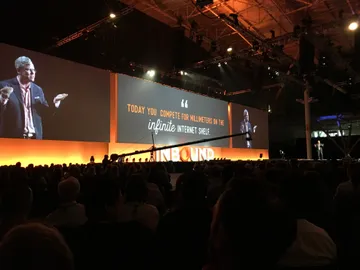
It was my first time at INBOUND, and it was the biggest conference I’d ever attended. I was surrounded by the people who create Facebook Ads, YouTube videos, and Snapchat filters for a living.
A few immediate observations about #INBOUND16:
I heard the word “content” more than my own name.
Everybody was affiliated with Hubspot — a partner, an agency, a client of an agency, a consultant, or Hubspot employees themselves.
I guess curse words are cool on stage. If you want people to laugh, or take you really seriously, say the f-word a lot.
- Easily over a million dollars was spent on the speakers, facility, and food and beverages. Keynotes as Serena Williams, Alec Baldwin, Anna Kendrick, and Gary Vaynerchuk are not cheap. Nor is free alcohol for 19,000 people for three nights.
On the spectrum of education vs. entertainment, I would put Inbound more on the entertainment side. Big celebrity names generate a high wow factor, but offer little this-helps-me-in-the-office-next-week substance. That said, the breakout sessions provided more practical takeaways and lessons to bring home.
The state of the web (and the future)
Brian Halligan and Dharmesh Shah, the two co-founders of HubSpot, gave a visionary past, present, and future state-of-the-digital-world address that rained hot chicken nuggets of dense brain-fuel for digital leaders, marketers, and sales teams.
Halligan said the supply of digital content is increasing rapidly, but demand has been flat since 2006. Everybody’s producing content on the Internet and it’s causing an exhaustive glut of endless information. Most of it is in the form of writing (i.e., blogs, articles, posts).
So Google came along. “Google and text are like pigs and a blanket,” said Halligan. “They’re a delicious combo.” But now it’s all about video. It’s how buyers learn. People don’t want to read anymore. They want to watch.
Then came social media. Social is how people collaborate — “Your networks are like your favorite coffeehouse,” said Halligan. “It’s where you’re comfortable.”
He emphasized that if you’re not on social media by now you might as well be marketing in a trash can.
Social media transformed the ad industry. First it was pay per impression, then pay per click, and now it’s pay per lead. Facebook is leading here.
Success in marketing is now a marriage between content and paid. “Add dollars to increase the viral coefficient of your content.” If you find a post doing well organically, throw a hundred dollars ad spend at it to maximize its impact.
“In 2006, the website augmented the salesperson. In 2016, the salesperson augments the website.”
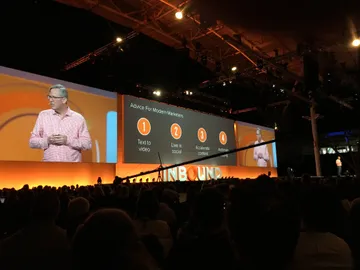
Advice from Brian Halligan, CEO of Hubspot:
Stop looking for the writer, look for the videographer.
Live in social. Otherwise, you’re in a trash can.
Accelerate (paid) and repurpose (Medium, YouTube) content.
The cold call is dead.
Email is still alive and well. Email still works if there’s context and research. Send 10 a day, not 100.
Regarding trials: people expect value before they buy. Let them test drive before they purchase.
Salespeople: Not ABC, ABH. Always Be Helping.
“With email, less is more. With cold calls, none is more. With trials, a taste is more.”
Use customers as your salespeople. Delight them so much that they want tell people about your company.
“It’s a terrible time to be a big company. It’s a great time to be a small business owner. Big companies hate change. Small companies are fueled by change.”
At this point, cofounder Dharmesh Shah, the self-proclaimed “nerdy technologist” of the pair, took over.
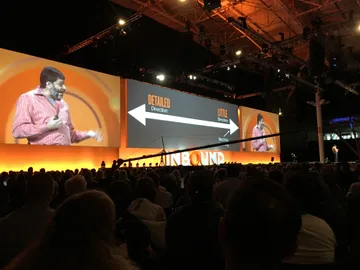
- He explained the power differences between Google, Facebook, and Amazon. “Google has the link graph. Facebook has the social graph. Amazon has the product graph.”
The key to digital success is not SEO, it’s HEO: Human Enjoyment Optimization.
- Two trends to get ready for: soon, all blog posts will be audio-enabled because we’re always on the move.
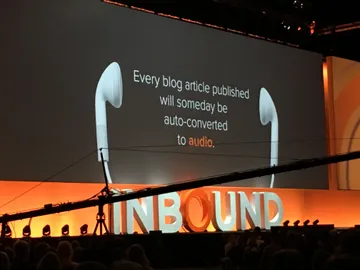
- He thinks web browsers will disappear, replaced by apps, specifically messaging apps.
Messaging is killing email. We’re seeing it now with Slack, Microsoft Teams, and Facebook At Work. The emergence of messaging introduced chatbots. Dharmesh thinks bots are the next biggest wave within the last two decades.
“People think it’s human vs. bot. No. It’s human to the bot power.”
All marketers are coders now
Introducing GrowthBot
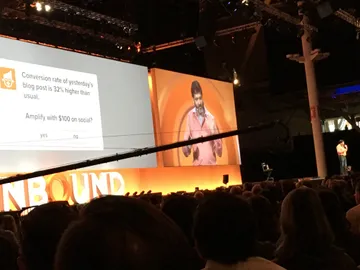
Dharmesh and his team built Growthbot, a chatbot for marketers, to accomplish tasks such as grading websites, inspecting software behind websites (like builtwith.com), showing top posts from a site, and retrieving analytics data.
GrowthBot allows a marketer to become a coder, of sorts, because, in the same way programmers use commands in certain code languages to perform complex tasks, a marketer can use GrowthBot to type in a command in natural language to perform a task. Here’s a screenshot of examples:
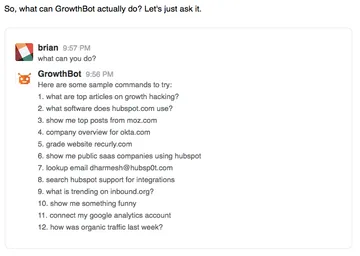
Chatbots allow marketers to become essentially non-technical coders. Dharmesh said,
“Decades ago, businesses started to build websites. Websites were an essential piece of doing business. Nearly every business has a website today. Soon, we will be building bots…”
If Dharmesh is right about the movement from websites to bots, then expect to see cousins of GrowthBot in the near future.
Nerd warning: quick #praise for the designers of the GrowthBot logo:

The GrowthBot logo is one of the most gorgeous, fascinatingly deep, and thoughtful logos I’ve ever seen. Here’s why:
The two commas appear as the profiles of two faces turned towards each other engaged in a conversation.
The two commas also form a symmetrical face with a friendly smile and strong nose bridge, a beautiful personification of “chat”.
The hair is both a bar chart swooping upwards, signifying the idea of growth, and also a youthful, fresh hairstyle demonstrating disheveled, beach-boy care-freeness.
The ears double as nodes, carrying a sense of end-to-end communication as well as human “listening”.
I love this logo. Thank you for giving me the pleasure of seeing it, Dharmesh Shah (edit: see his comment below).
That which makes a blog post viral
Tim Urban, the mind and pen behind the popular Wait But Why, is a clever fellow. He is at the helm of blogging innovation — if you’re wondering what your blogs should look/sound/feel like, read his stuff. With over half a million monthly readers, he shared at INBOUND about what makes a blog post go viral.
Write for Curious Babies. People want depth, but they want it to be easily understood depth. Urban takes huge, complex ideas, such as the wars in Iraq, or Elon Musk’s vision of life on mars, and simplifies them down into relatable concepts.
Write for the million Tims. Instead of writing for everyone, Urban writes for the million Tims that are just like him. He said to write about what you are genuinely passionate about, because there are at least a million people just like you in the world. In my case, I would be writing for the million Daves.
Write fiction to make the blog post fun and pleasurable to engage with. Blog posts should introduce a story arc, drama, and a sense of conflict. People love drama. Weave imagination into the blog post to create an experience and avoid the boring textbook.
Write using visuals, symbols, and terms for stickiness. Tim Urban uses stick figures and line graphs to illustrate social phenomena that would otherwise require a thousand words to explain. He gives names to his concepts; for example, the “dark playground” is his symbol for “procrastination.” Impact comes from memorability, and terms give our brains a bucket to store information in (stickiness).
The one book I bought from #INBOUND16
People say you write how you speak (or is it speak how you write?), so if author and New Yorker journalist Charles Duhigg’s books are even half as good as he speaks, then I’m in. The two words I’d use to describe his talk about the science of productivity: tight and meaty. Zero rambling, and story after story, Malcolm Gladwell-style.
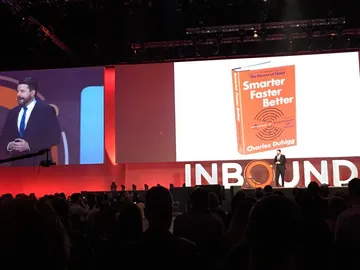
The two points about psychology that I took away from Duhigg’s talk were:
Have a contemplative routine. Duhigg told a story about a fellow who wrote twenty-page letters to his friends almost every night. His friends didn’t even read them, they were too long. But it didn’t matter. The routine of writing letters paved the path for the man to become a best-selling author. A contemplative routine could be yoga, stogies, baking, or biking — a space that allows you to process through creative ideas.
Motivation expands when we feel in control. This struck me as fascinating. Duhigg’s point was if I’m feeling unmotivated, a lot of things in my life are probably outside of my control. The more control I have, the greater my motivation. Thus, the importance and power of habits: habits increase control over my life. As an example, Duhigg told the story of how Starbucks trains its employees to “Latte” unhappy customers:
Listen
Acknowledge the problem
Take problem-solving action
Thank them, and
Explain what you’ve done
This system gives Starbucks employees a way to address a potentially uncontrollable situation in a controlled manner, yielding mutual happiness.
One lesson from the Tesla VP of Sales
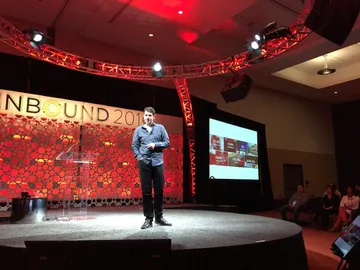
“We don’t sell.”
— Jon McNeill, VP of Sales for Tesla Motors.
Tesla can’t afford an advertising or marketing budget and yet they have managed to double the revenue of a $5 billion automobile company.
“We educate and present the product,” McNeil said, “But we don’t sell.”
Equipped with facts and stats, Tesla salespeople are trained to educate customers about the mortality rate caused by CO2 emissions and problems with vehicle safety. For example, exhaust from gas engines can create cancer-inducing poisonous smog in dense cities, and engine placement in a traditional sedan can kill the driver in a head-on collision (i.e., with a telephone pole).
The sales team simply lets the customer test drive the product. With record-setting acceleration, software-based user interface, and environmental and safety benefits, Tesla vehicles sell themselves. Musk was so particular in regard to the design that Mcneil recalled Musk saying in a review of the finished Model 3, “There’s too much blue in the mirror.”
Wrap Up
INBOUND 2016 was an amusement park brimming with marketing and sales professionals, digital tools, and insightful stories from the lives of the daily office dweller up to the big screen stars.
With so much to see and learn, it would’ve be impossible to come away without any ideas or inspirations, and if you weren’t able to attend, there’s always Inbound 2017 (and recaps like this, so you can avoid large crowds of overly-caffeinated extroverts live-tweeting Rand Fishkin’s Google SEO Flywheel hacks).